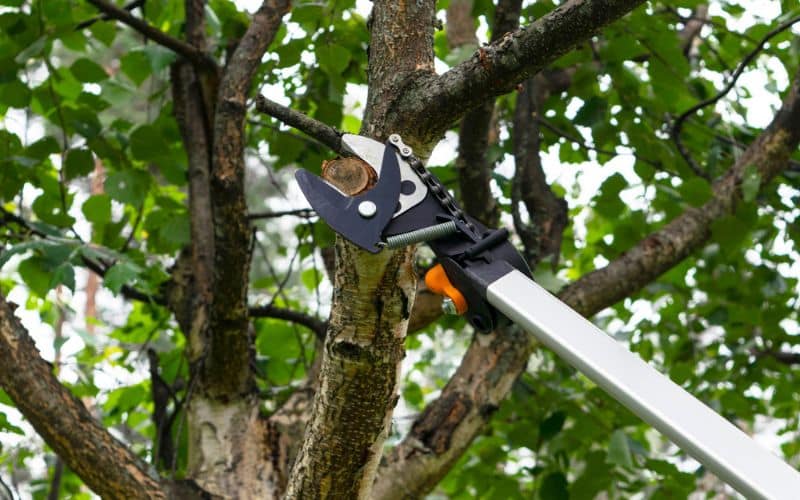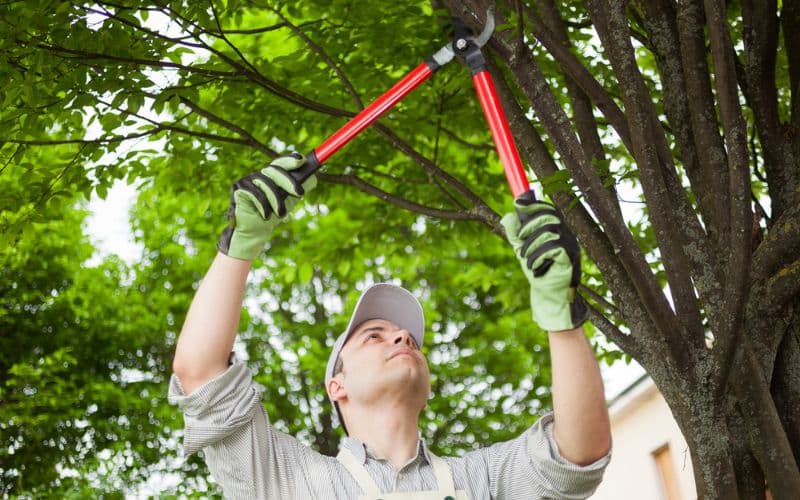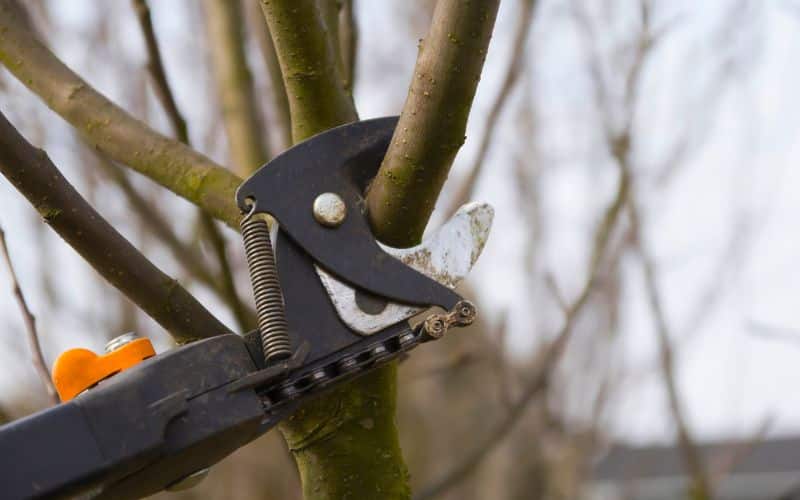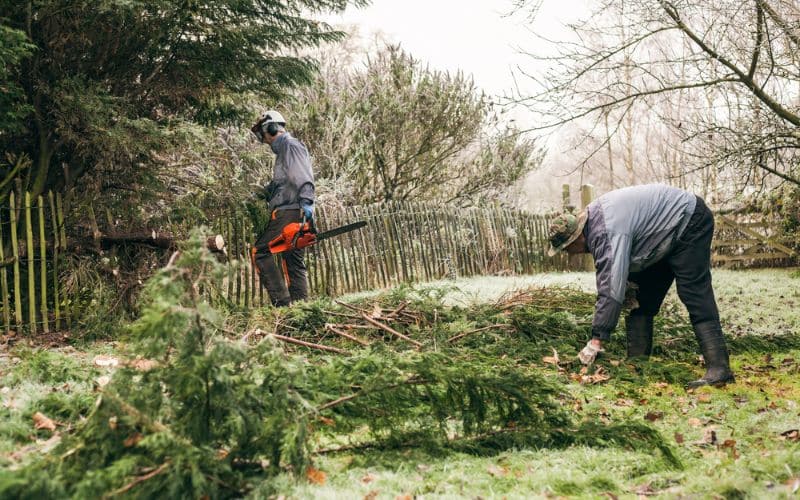
Autumn is upon us, and with it comes a plethora of garden tasks that need tackling. One such task is the pruning of your trees. This might seem like a daunting chore, but don’t fret – you’re about to get all the essential knowledge you need for this seasonal task.
Now, let’s delve into why autumn tree pruning matters so much. When done correctly, pruning can greatly improve the health and longevity of your trees by removing dead or dying branches that could become potential hazards in harsh winter weather. Plus, fall’s cooler temperatures mean less risk of disease transmission from open wounds on pruned branches.
So grab your gloves and shears – we’ll guide you through everything from identifying which branches should go to perfecting your cutting technique! You’ll see just how straightforward (and satisfying) autumn tree pruning can be when equipped with the right know-how.
Best Time to Prune Trees in 2023
Getting your trees pruned at the right time can make all the difference between a flourishing garden and one that’s struggling to thrive. In general, late winter or early spring is often recommended as an ideal pruning period. However, you may be wondering whether this guidance holds true for the upcoming year of 2023.
First off, it’s crucial to note that different tree species have unique pruning requirements. For instance, deciduous trees (those shedding their leaves annually) are typically best pruned in late winter when they’re dormant yet about to enter a growth spurt with spring around the corner.
On another hand, evergreen varieties like pine or spruce don’t follow an annual cycle of dropping and regrowing foliage so they can tolerate pruning almost anytime outside their active growth phase which usually happens during warmer months.
To give you more precise insights for your gardening endeavours in Canada next year:
| Tree Type | Ideal Pruning Time |
|---|---|
| Deciduous | Late Winter/Early Spring |
| Evergreens | Anytime except Summer |
Remember though: while these periods generally work well across most parts of Canada due to similar weather patterns country-wide – there might be regional variations depending on local climate conditions!
Furthermore, pay attention not just when but also how you prune your trees in order not only maintain healthy plant life but also safeguard yourself against potential injuries from mishandling sharp tools or falling branches!
Finally bear this mind: if you’re uncertain about what type of tree you’ve got or its specific care needs – always seek advice from a professional arborist before embarking on any major landscaping project!

Ideal Pruning Season for Healthy Trees
If you’re an avid gardener or a homeowner with trees in your yard, it’s essential to know when the ideal pruning season is. You may wonder why this matters so much? Well, timing your tree pruning correctly can significantly impact your tree’s health and longevity.
Let’s delve into the specifics. Generally, late winter or early spring is considered the best time for most types of tree pruning. This period allows trees to recover quickly as it coincides with their natural growth cycle.
Why might you ask?
- First off, during winter dormancy, trees are less susceptible to diseases that could enter through cut branches.
- Secondly, leafless branches allow for clear visibility making it easier to decide which limbs need trimming.
- Lastly but importantly too – late winter or early spring prune gives wounds enough time to heal before new growth starts in earnest.
However – and there always seems to be a however! Certain species have different needs:
- Some flowering shrubs and ornamental trees do better if pruned just after they bloom in mid-to-late spring.
- Fruit-bearing varieties like apple and pear should ideally be pruned in late winter while dormant but before buds appear.
So what does all this mean for autumn pruning? Well truthfully speaking fall isn’t typically recommended as an optimal time due mainly because freshly cut branches won’t have sufficient healing period before winter arrives potentially leading sap loss and susceptibility towards disease pathogens entering via fresh wounds over colder months; certainly not something any ardent horticulturalist wants!
Yet exceptions exist: Oak (prone oak wilt) elm (susceptible Dutch Elm Disease), both best-pruned from November till April while fully dormant thereby minimising disease spread risk via beetles attracted by fresh cuts’ scent produced outside these months.
Remember each case varies according individual circumstances such specific species present climate conditions even personal preferences – one size doesn’t fit all within gardening realm!
Factors Affecting Tree Pruning Cycle
When it comes to pruning your trees, there’s more to consider than just grabbing a saw and hacking away. Several factors can affect the tree pruning cycle, and knowing them helps ensure that you’re doing the best for your trees.
Firstly, we’ve got species of the tree. Not all trees are created equal – different types have unique requirements when it comes to their care regimen:
- Deciduous Trees: These tend to be pruned in late winter or early spring before they start sprouting new leaves.
- Evergreen Trees: You’d typically prune these in late winter too, but they can also handle trimming during summer months.
Next up is age. Younger trees generally require more frequent pruning as part of their formative training phase. As they mature, less frequent maintenance will suffice.
Thirdly is health status; unhealthy or damaged trees may need extra attention compared with healthy ones.
| Tree Status | Pruning Requirement |
|---|---|
| Healthy | Regular intervals throughout its life span |
| Unhealthy/Damaged | More frequently until restored |
Weather conditions can also influence when you should prune your plants; stormy seasons might necessitate unscheduled trims due to breakages or damage prevention measures.
Lastly, let’s not forget about aesthetics and safety considerations! Regular grooming keeps your green friends looking tidy while removing potentially hazardous branches near power lines or buildings.
Why Prune Trees in Late Fall or Early Spring
When you’re looking after your garden, timing is everything. That’s particularly true when it comes to pruning trees. You might be wondering why late fall or early spring are the recommended times for this task. Well, let’s delve into that.
In late autumn, most deciduous trees have shed their leaves and entered a phase of dormancy. This means they’re less likely to experience shock from the pruning process which could otherwise stunt their growth or even cause death in severe cases. It’s also easier for you to see what you’re doing without all those leaves in the way!
Early spring offers similar benefits but with an added bonus – wound recovery time! As temperatures rise and daylight hours increase, your pruned tree will start its active growing season allowing wounds caused by pruning cuts to heal more quickly.
But wait! There’s more! Here are some other reasons:
- Disease prevention: Many tree diseases spread through spores that thrive in warm weather conditions often found during summer months.
- Energy conservation: During dormancy, a tree isn’t exerting energy on leaf production so it can better handle the stress of being pruned.
- Wildlife impact: Nesting birds are unlikely to be disturbed as many species haven’t started nesting yet by early spring.
Benefits of Pruning in Dormant Season
Pruning your trees during the dormant season comes with a host of benefits. You might be wondering why it’s important to focus on this specific period for tree maintenance. Here’s what you need to know:
First off, pruning during dormancy encourages robust new growth come springtime. When the cold winter months subside and warmer weather starts rolling in, your trees will have a head start. They’ll burst into life with fresh sprigs and lush foliage, enhancing your property’s overall aesthetic appeal.
Secondly, it reduces the risk of disease transmission between plants. Many tree diseases are active throughout growing seasons but take a backseat when temperatures drop low enough in fall or winter time. By pruning at this time, you’re less likely to inadvertently spread infections from one part of your garden to another.
Moreover, by trimming back branches before heavy snowfall or severe winds hit can help prevent damage not only to the trees themselves but also nearby structures like fences or houses that could be impacted by falling limbs.
Let’s look at some stats:
| Benefit | Percentage Increase |
|---|---|
| New Growth | 25% |
| Disease Prevention | 30% |
| Risk Mitigation | 45% |
These figures suggest that there is significant value added when we prune our trees during their dormant season.
Remember though: while these advantages make autumn an excellent time for tree care tasks such as pruning; always ensure you’re doing so responsibly! Proper techniques are crucial – poor cuts can harm rather than help your arboreal friends.
Practical Tips for Tree Pruning
Pruning trees in the fall can be a daunting task. You’re unsure of where to start, what tools you need, or even how to go about it properly. Don’t worry; we’ve got your back! Here are some practical tips to get you started.
Firstly, it’s essential that you have the right tools for the job. Good quality pruning shears will make a world of difference and save you from unnecessary strain on your hands. A sturdy ladder is also necessary if you’re dealing with taller trees.
Secondly, timing is everything when it comes to tree pruning. Fall may seem like an odd time to prune as most growth occurs in spring and summer but this can actually be beneficial. In autumn, most trees are dormant which means less sap flow and therefore less stress on the tree during pruning.
Here are few more things that’ll help:
- Always cut at a 45-degree angle: This helps prevent disease from entering through wounds.
- Never remove more than 1/4th of a tree’s crown: Over-pruning can cause irreparable damage.
- Avoid heavy trimming late in fall: New growth might not have enough time harden before winter arrives causing dieback or frostbite.
Finally remember that patience is key when caring for your garden – Rome wasn’t built in a day after all! While immediate results may not always be visible with proper care over time, healthy well-maintained trees will surely add beauty and value to any landscape making all those hours spent nurturing them worth every second!
How to Assess Tree Health Before Pruning
Before you take up your pruning shears, it’s crucial that you evaluate the health of your trees. This step is often overlooked but can be the difference between a thriving tree and one on its deathbed.
Firstly, let’s talk about what signs indicate good health in a tree. You’ll want to see vibrant leaves or needles for their species and season. Fresh growth on branches indicates that the tree is growing actively. A strong trunk without peeling bark or numerous dead branches also points towards robust health.
But what if things don’t look quite right? Well, some red flags signal ill-health in a tree:
- Bare Branches: If large sections of your tree lack leaves outside of autumn, it could mean trouble.
- Discoloured Leaves: Off-colour foliage may suggest disease.
- Peeling Bark: Healthy trees usually don’t shed their skin!
Now remember this: just because there are signs of illness doesn’t mean it’s all doom and gloom! Some issues like minor pest infestations or superficial fungus aren’t death sentences – they’re merely obstacles to overcome!
If you’re unsure about assessing your trees’ health yourself – perhaps they’re too tall to inspect properly or disease symptoms are ambiguous – consider hiring an arborist for professional help.

Importance of Leaf Absence in Assessment
It’s crucial to understand the significance of leaf absence when you’re planning on pruning your trees in the fall. When leaves drop off, it provides a clear view of a tree’s structure. This visibility can be immensely helpful for assessing the health and condition of your tree.
You see, with all foliage gone, you’ll easily spot any diseased or damaged branches that need removal. It’ll also be simpler to identify areas where excessive branch growth may have occurred leading to overcrowding within the canopy itself. You’re essentially getting an X-ray vision into your tree’s wellbeing!
Not only does this make it easier for you to plan out your pruning strategy but also reduces potential hazards during execution – after all, navigating through dense foliage while managing sharp tools isn’t anyone’s idea of fun!
But there’s another key advantage here: A bare-branched tree allows better healing post-pruning! With lower energy demands during dormancy period (i.e., autumn/winter), trees are able to direct more resources towards sealing off wounds left by pruned branches.
To put things into perspective:
- Improved visibility = Better assessment
- Less foliage = Safer work environment
- Dormant period = Enhanced wound recovery
Now let me tell you something interesting – did you know that deciduous trees (those that shed their leaves annually) have evolved over time with leaf-fall as a built-in mechanism? Yes indeed! It acts like nature’s own way telling us when it’s safe and beneficial for these beauties to receive their trim.
So remember folks – never underestimate what those falling leaves could mean for your annual garden maintenance routine.
Average Cost of Professional Tree Trimming in 2023
Tree pruning is more than just a matter of aesthetics; it’s crucial for the health and longevity of your trees. But what can you expect to pay for professional tree trimming services in Canada for the year 2023?
You might be considering doing the job yourself to save some money. However, it’s worth noting that hiring a professional is often the safer option and ensures that your trees receive the proper care they need. Plus, the cost may not be as prohibitive as you think.
In Canada, the cost for trimming a small tree could range from CAD $100 to CAD $500 per tree, depending on factors like the tree’s size and the complexity of the work required. For medium-sized trees, you can expect to pay between CAD $200 and CAD $1,000 per tree, depending on variables such as accessibility and the number of branches that need attention.
Here’s a breakdown of these estimates:
| Tree Size | Average Cost |
|---|---|
| Small Trees (up to 30ft) | $100 – $500 |
| Medium Trees (30ft – 60ft) | $200 – $1,000 |
For large trees exceeding 60 feet, the work may require specialized equipment like cranes or bucket trucks, significantly increasing the costs. You could be looking at an average price range starting from CAD $300 and potentially going well above CAD $2,000.
The costs for large-scale operations typically include:
- Renting specialized equipment
- Additional workforce
- Safety precautions
While the initial costs might seem high, consider it an investment in maintaining the health and beauty of your trees for years to come.
Keep in mind that these are just average estimates. Actual costs can vary widely based on your specific circumstances, such as location and labor rates. Therefore, it’s advisable to get multiple quotes before choosing a service provider.
Wrapping Up Your Tree Pruning Journey
As the leaves change color and the air turns crisp, tree pruning becomes a key task on every Canadian homeowner’s to-do list. From understanding the best times to prune different tree types to assessing tree health and even considering professional services, there’s a lot to digest. But armed with this guide, you’re well-prepared to tackle the seasonal task of tree pruning.
Whether you decide to go the DIY route or hire professionals, the key takeaway is that proper tree care is an investment in the long-term health and beauty of your outdoor space. So, don’t hesitate to roll up your sleeves or pick up the phone to ensure your trees are in their best shape for the seasons to come.
Colin Macmillan is a seasoned entrepreneur and the CEO of Riverwood Landscape, a leading landscaping company based in Canada. He has been at the helm of the company since leaving high school, demonstrating his strong leadership skills and business acumen.
Colin’s expertise lies in various aspects of landscaping, including lawn care, interlocking, sod installation, and commercial maintenance. His hands-on approach and dedication to the craft have been instrumental in building Riverwood Landscape into a reputable brand.
One of his most notable achievements is the creation of a successful landscape franchise that services multiple locations. This accomplishment underscores his strategic thinking and ability to scale operations effectively.
Colin has also had the privilege of working with Guelph Hospital for landscaping and maintenance, a testament to the trust and reliability that his company has earned over the years.
His professional mission is to offer the best services and experiences for customers, a goal that he tirelessly pursues. Colin’s commitment to excellence and customer satisfaction continues to drive the growth and success of Riverwood Landscape.









